Most of us understand the value of planning and preparation. A sports match without a game plan means fumbling on the field. A big event without all the details in place leads to chaos.
Despite this knowledge, we often fail to prioritize planning where it matters most: our daily lives. Getting started in the morning without a clear plan sets us up to fail.
We set goals on the order of seasons and years, but it’s what we do each day — the habits we adopt, the tasks we complete, and the things we prioritize — that compound over time into success or failure. A few aimless days each month can help us reset and find balance. But when our days without intention exceed our days with purpose, we end up missing our goals and wondering where all the time went.
The best defense against hectic yet unproductive days is a good offense in the form of a daily planning ritual. This article will walk you through how to plan your days for calmer, more focused productivity that brings you closer to your goals. While planning your day should only take 10-15 minutes, the underlying strategies to meaningfully craft a day with intention are worth exploring in full.
Make regular planning a habit
James Clear, the best-selling author of Atomic Habits, thinks motivation is overrated: “Stop waiting for motivation or inspiration to strike you and set a schedule for your habits”. Motivation flows from action, not the other way around.
That’s why having a daily planning ritual is so important. Some mornings we feel motivated to seize the day and create a to-do list that reflects our big ambitions. But those days are the exception. We need to get things done even when we wake up tired and disengaged, wanting to return to bed or longing for Friday at 5 PM. Those are the days it’s most important to approach the day with a plan.
Start by setting an alarm for your daily planning session at the same time every day — either during a work shutdown ritual or first thing in the morning. To make building the habit easier, bundle your new daily planning session with an existing habit like drinking your morning coffee or listening to music.
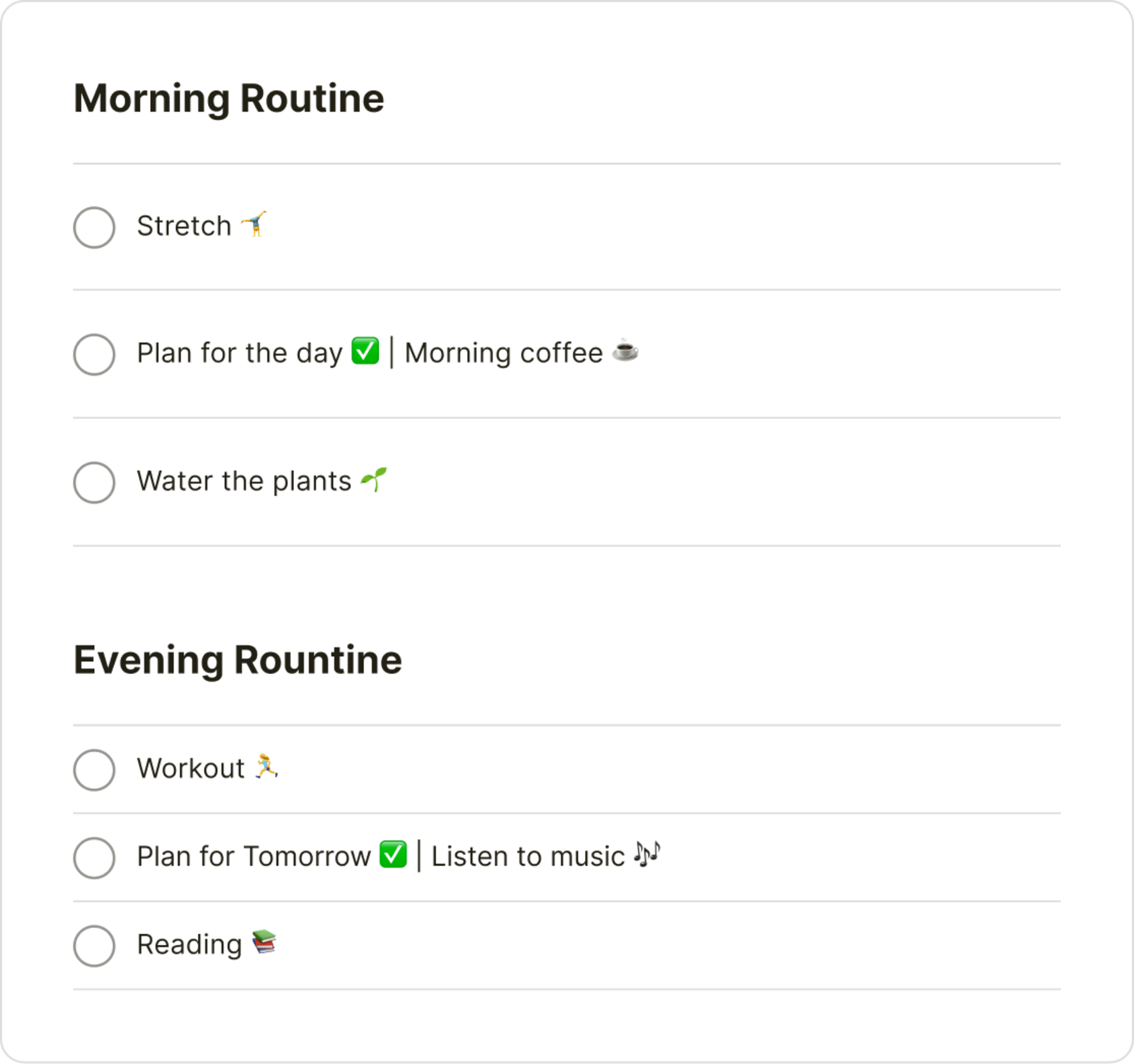
Use a to-do list app like Todoist to set a recurring task to plan your day, or simply set an alarm on your phone.
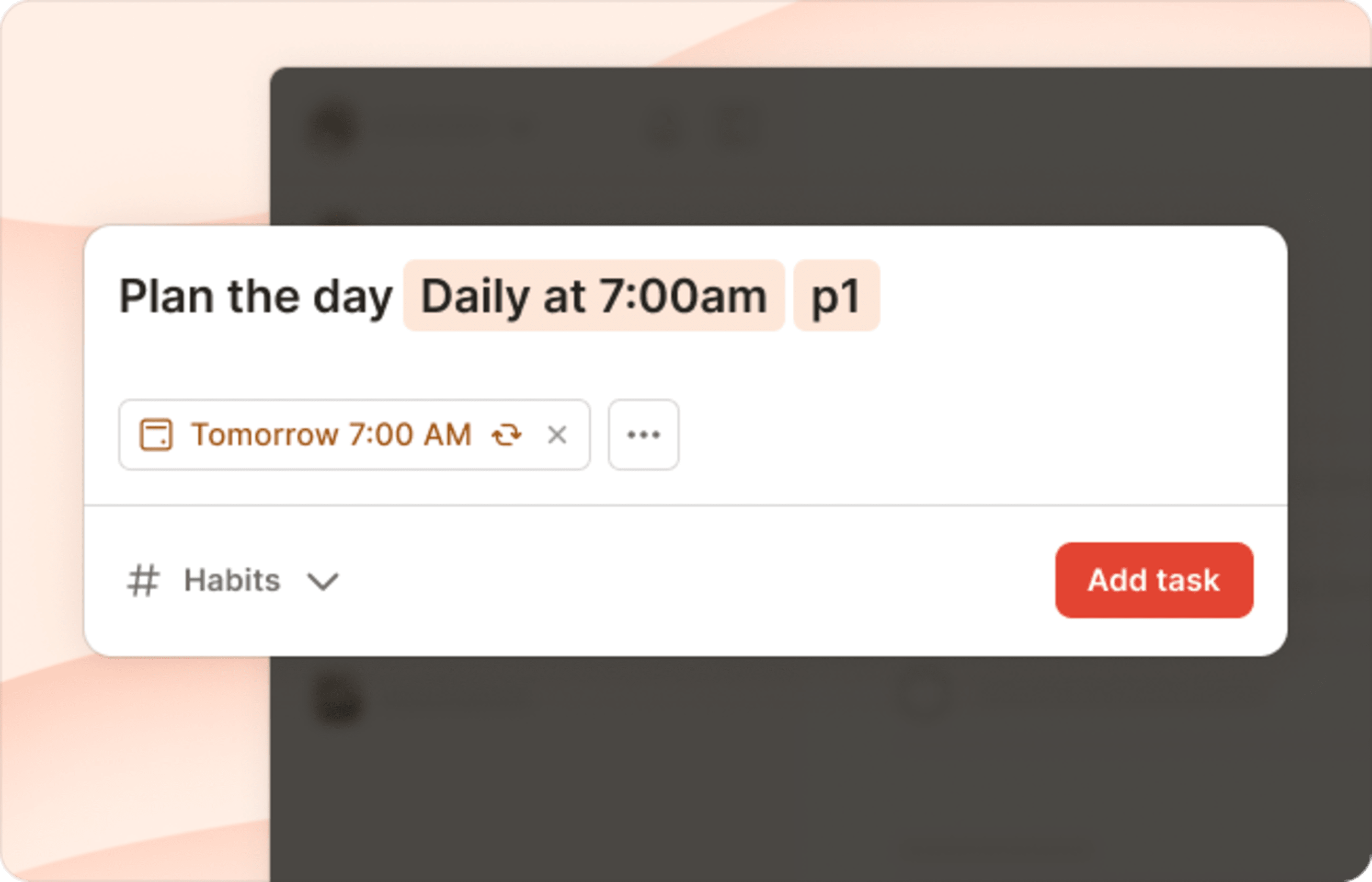
Habits are easier to build when we see the results of our dedication right away. Luckily, planning your day is a habit that pays off immediately. You’ll feel more organized, focused, and motivated with a plan for the hours ahead. Over time, planning your day will become second-nature.
Build your to-do list around your goals
Making a habit of your daily planning is one thing. Ensuring that your plan is actually inching you towards your bigger goals is another. Use your daily planning session to make sure your daily tasks are aligned with your long-term objectives.
A few steps to help you align your tasks with your objectives are below, but we also have the goal tracker template to help you jumpstart your big picture planning.
Step one: Break down your big goals
Break down your goals into daily tasks. For example, you can’t add “Get in shape” to your daily to-do list, but you can add tasks like “spend 30 minutes on my Peloton” or “go for a nightly stroll”. Review your personal and professional goals when you sit down to plan your day, and add tasks that get you closer to both.
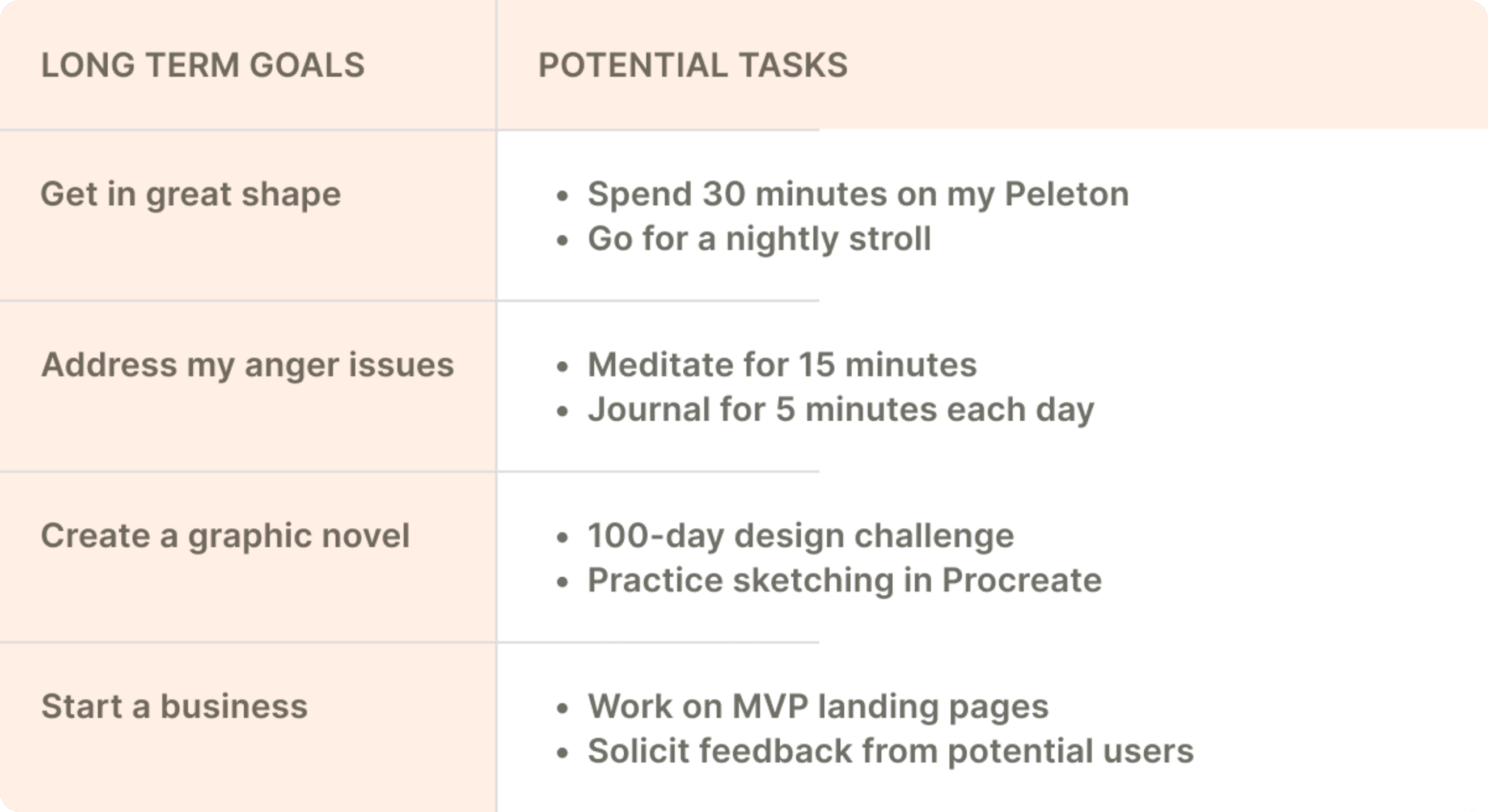
If you’re struggling to create realistic daily to-do lists that reflect all of your goals, you may have too many. Overextending yourself isn’t only tiring, it also means you’re unlikely to make meaningful progress in all these areas. Complete a commitment inventory to hone in on a smaller number of goals that are most important to you. As a general rule, avoid having more than 5 big goals at once, and consider a mix of short-term and long-term goals.
Step two: Look at your week as a whole
Planning your day starts with considering your week as a whole. You likely have multiple goals, an array of potential tasks to accomplish them, and only so many hours in the day. That’s okay. While some goals benefit from daily action, working towards others a few times a week can create momentum. Maybe you exercise Mondays, Wednesdays, and Fridays. On some days, you may want to task batch and focus only on to-dos related to one specific professional goal. Alternatively, you might stack your personal goal tasks on the weekend. Take the time on Sunday evening or Monday morning to zoom out and lightly sketch your week so you know which goals you’ll focus on and on which days. Save the details for your daily planning sessions.
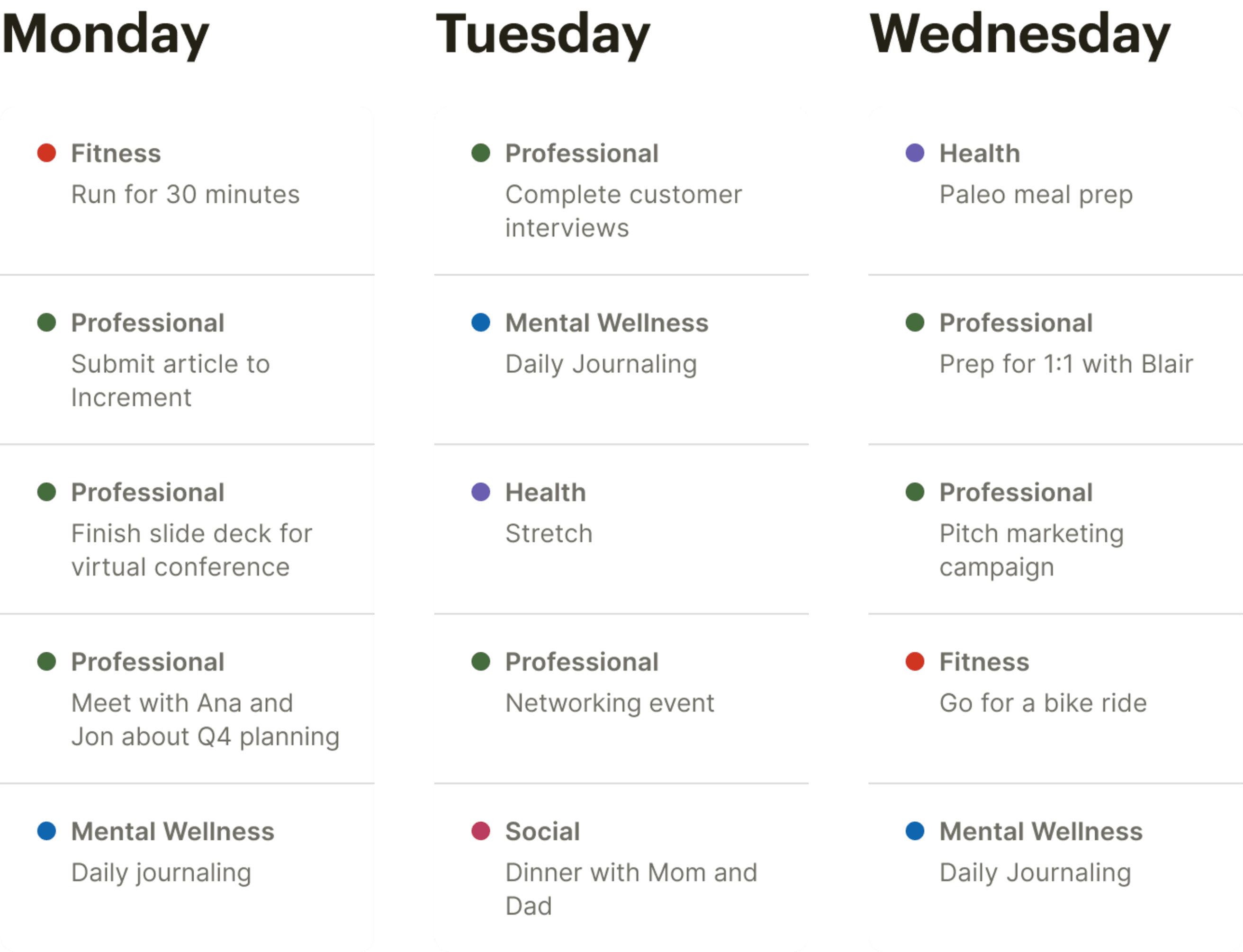
Step three: Add your have-to-do tasks last
This is the step that most people start with when they plan their day. They begin with their set appointments, mandatory meetings, urgent deadlines, and then try to fit goal-oriented tasks around them. Instead, consider keeping this step for the end. This way, you’re forced to fit your have-to-do tasks around your goal tasks rather than the other way around.
In an ideal world, we would focus only on daily tasks that move us toward our long-term goals. In reality, we have commitments and obligations that we have to fulfill — some of which have little impact on our personal or professional growth. Cull these commitments and obligations as much as possible: reevaluate recurring meetings, consider delegating responsibilities, and get comfortable with saying “no”. However, it’s okay to have things on your to-do list that simply need to get done. Just make sure they aren’t taking over too much of your time and energy.
Have one daily priority
Many of us start our mornings with dozens of things we need to get done only to realize at the end of the day we haven’t crossed any of them off our lists. Sure, we got stuff done, but none of the things we planned. The counter-intuitive solution for getting more done? Pick just one big task per day.
You may be thinking: “How can I achieve all my goals if I only focus on one task per day?”. In Make Time: How to Focus on What Matters Every Day, Jake Knapp and John Zeratsky discuss the sneaky phenomenon of busyness without productivity. In between meetings and ad-hoc requests, it can feel like we’re on a treadmill we can’t get off.
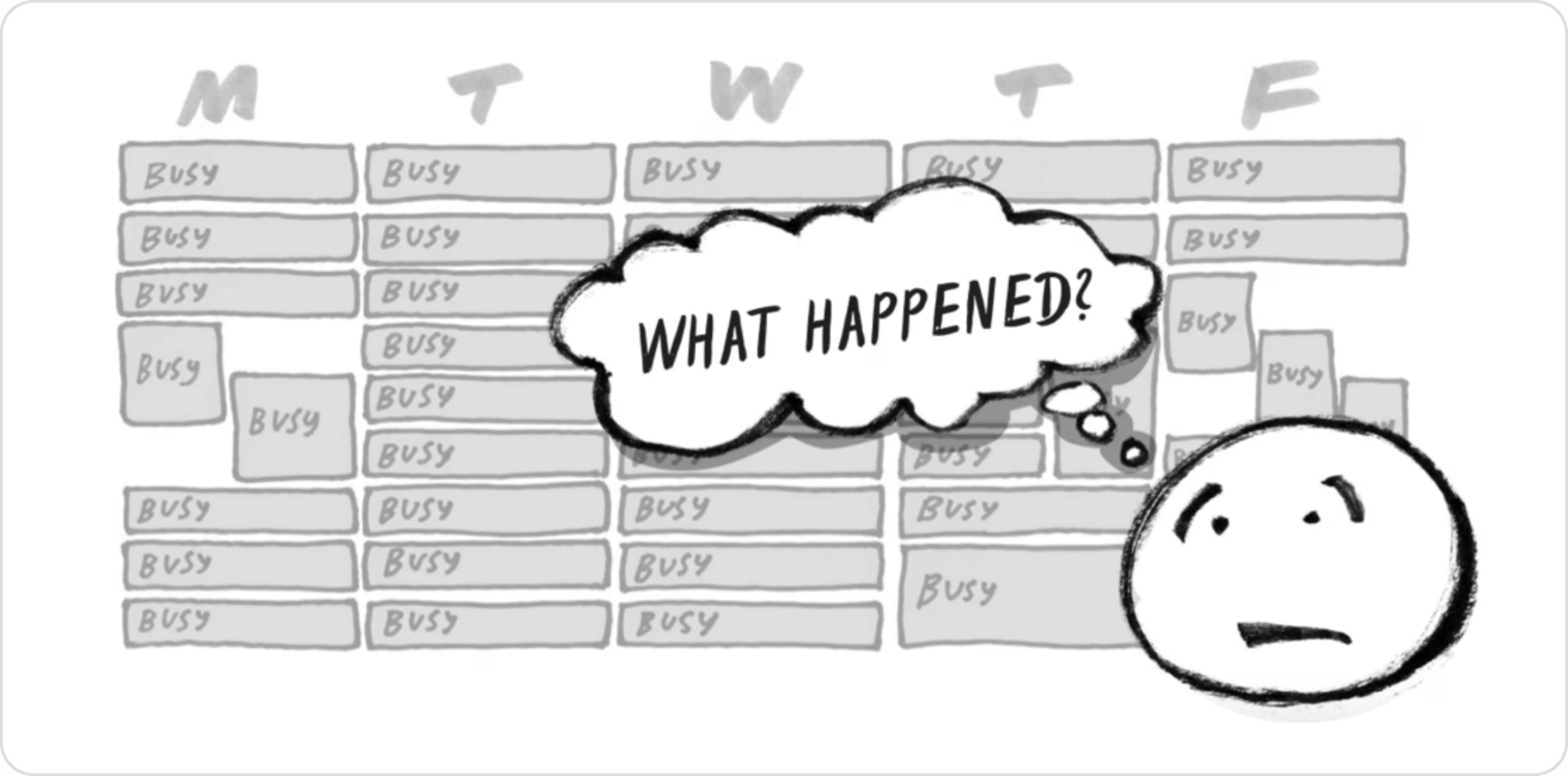
As a balm against hectic days that pass without progress, they introduce the concept of the “Highlight”:
“The first step...is deciding what you want to make time for. Every day, you’ll choose a single activity to prioritize and protect in your calendar.”
If you’re struggling to select what your Highlight or top priority for the day might be, Knapp and Zeratsky suggest this simple heuristic:
If we’re being honest, ending the day with at least one big task out of the way is a marked improvement over what many of us are doing now. On a longer time-scale, finishing 5-7 big things per week is significant. Does that mean you’ll only complete one task per day? Generally, no. However, selecting and completing a single significant to-do fills us with a sense of accomplishment that creates momentum to tackle other tasks too.
Use a task manager like Todoist to mark the Highlight for your day as high priority and move it to the top of your list.

Alternatively, if you’re opting for pen and paper productivity, simply star, highlight or underline the most important task on your to-do list in your notebook or daily planner.
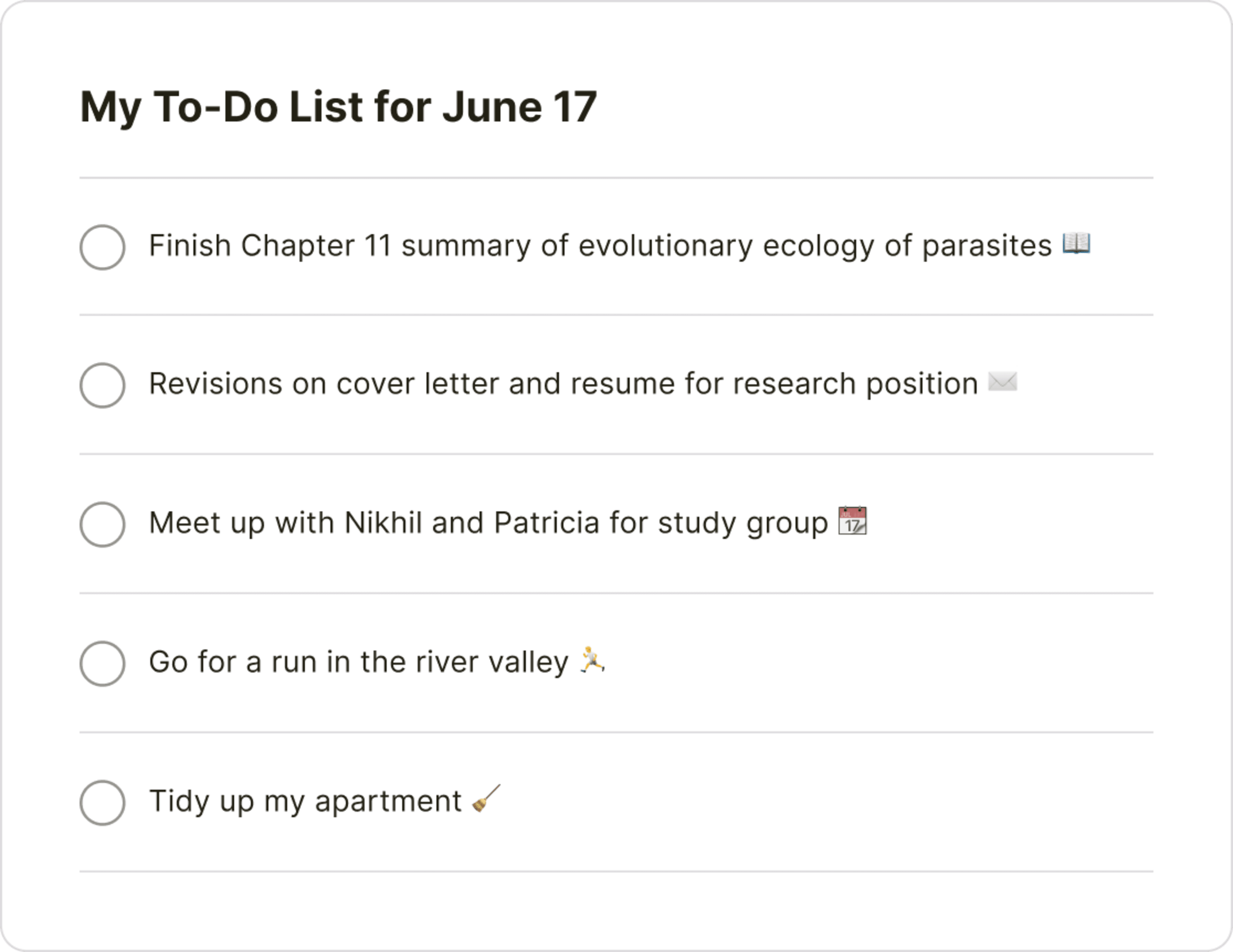
Regardless of the tools you use, make extreme prioritization a key part of how you plan your day.
Plan your day with a productivity method
A productivity method is both an effective way to get things done and a strategy for planning your day.
Below, we share a few popular productivity methods you can choose from to tackle your tasks and how to use them for daily planning. Find a productivity method that works for you –– even if that means remixing an existing one or creating a new one from scratch. Some popular methods for daily planning to get started with are below. Or, take a look at our templates gallery to see if any templates could help you plan your day.
Eat the Frog
The Eat the Frog productivity method asks you to identify one important task for the day and do it first. This is a great method for putting your highlight into action early. Sometimes it’s the task we most want to avoid (hence, eating the frog). This could be the task that feels too big to tackle or the one that makes us uncomfortable. Attack it straight away before you have a chance to procrastinate.
During your daily planning session, put your “frog” task at the top of your to-do list and assign a time. Then, place your other tasks below.
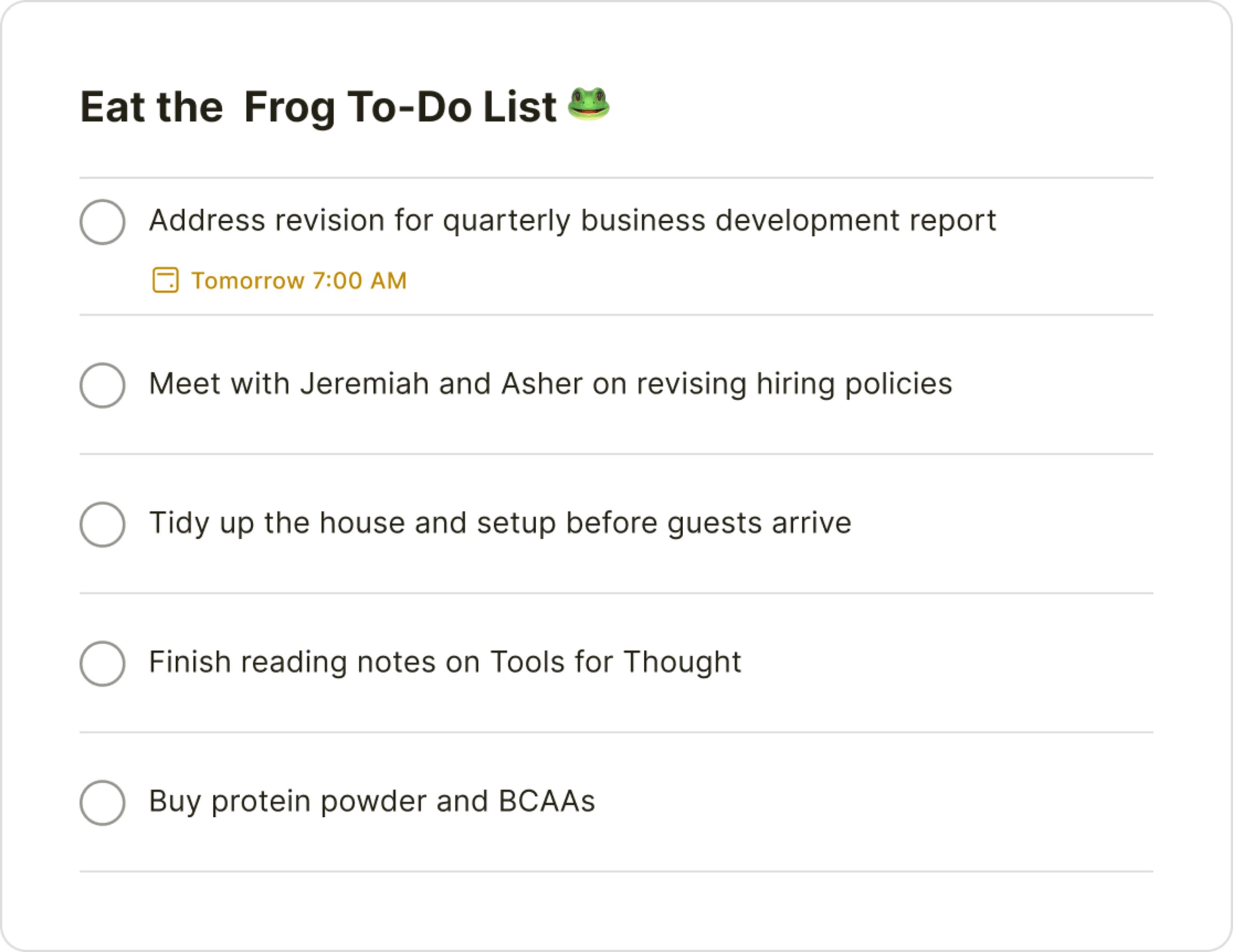
Pomodoro Technique
The Pomodoro Technique is best for people who enjoy working in short focused sprints with frequent breaks. This method was developed in the late 1980s by Francesco Cirillo, then a struggling student, who committed to just 10 minutes of focused study using a tomato (pomodoro in Italian) shaped kitchen timer. This method includes the following steps:
- Get a timer.
- Set your timer for 25 minutes, and focus on a single task until the timer rings.
- When your session ends, mark off one pomodoro and record what you completed.
- Enjoy a five-minute break.
- After four intervals, or “pomodori,” take a longer, 20- to 30-minute break.
To plan your day with the Pomodoro technique, estimate how many pomodoros (25-minute work sessions) you’ll need to complete each task on your list. Note that number in front of each task with a tomato emoji or simply the number itself in brackets. This method forces you to consider how long your work will take and plan accordingly. You can opt to use pomodoros for your entire day or simply use the method for your top task.
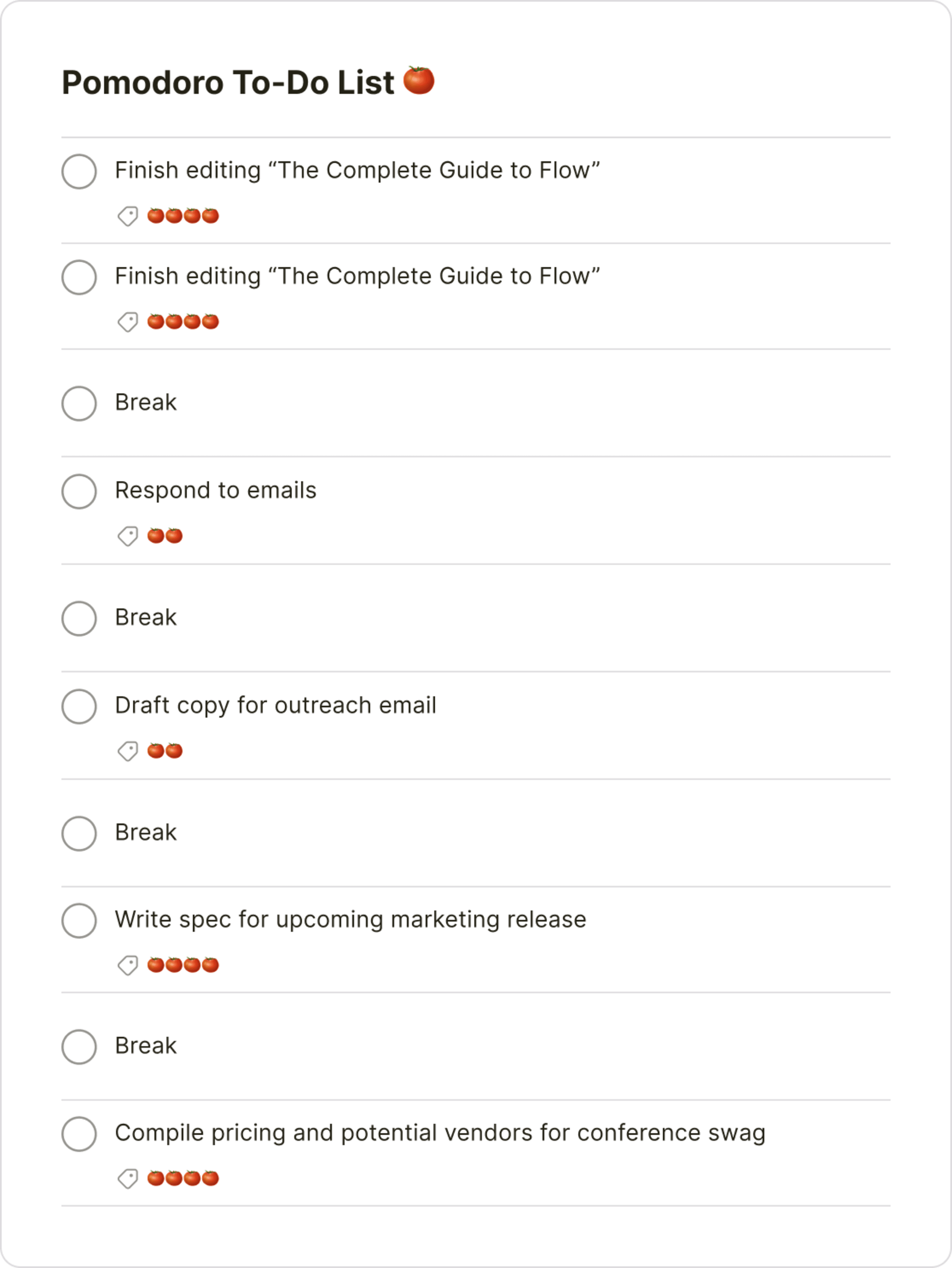
Time Blocking
With the Time Blocking productivity method, split up your day into distinct blocks of time. This could be as specific as 9:30AM-11:30AM or simply “Morning” depending on how long a task might take. Then, work without distraction and dedicate each block of time to completing only a specific task or set of tasks.
Like the Pomodoro technique, this method will help you estimate and understand how long your to-dos take. Make sure to include blocks for things like lunch, breaks, and commutes for the most accuracy. Often a task will take more or less time than you anticipate. That’s okay. Make quick modifications to your list as you move through the day. With time, you’ll get a better understanding of how long tasks take. In the meantime, a good rule of thumb is to double the amount of time you think something will take.
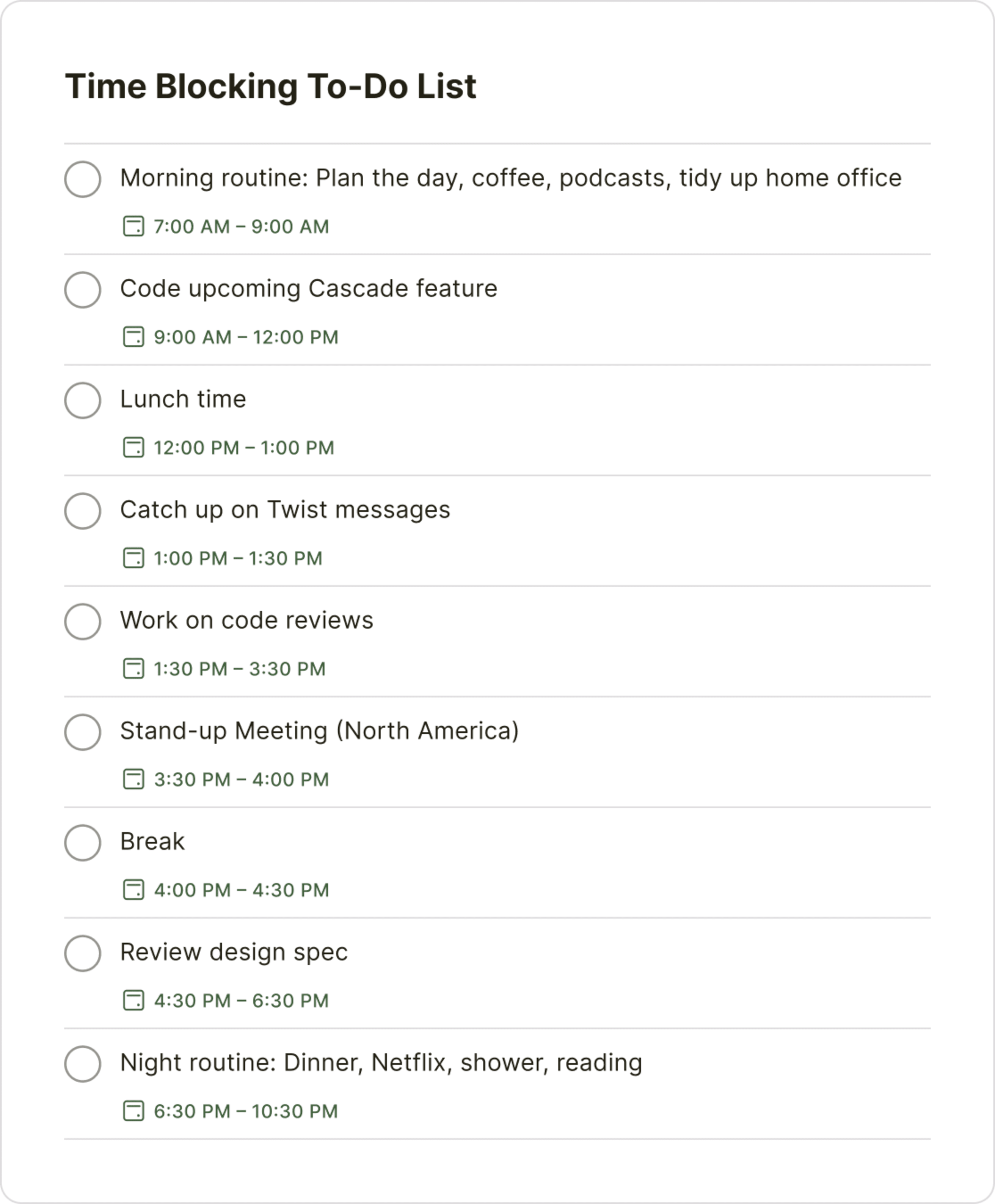
Eisenhower Matrix
The Eisenhower Matrix productivity method forces you to consider the urgency and importance of each task, instead of only doing what’s most urgent — whether it’s crucial or not. This method breaks down tasks into four quadrants and prescribes how we should deal with tasks that fall into each one:
- “Urgent and Important” tasks should be completed immediately
- “Not Urgent and Important” tasks should be scheduled on your to-do list or calendar
- “Urgent and Unimportant” tasks should be delegated to someone else
- “Not Urgent and Unimportant tasks” should be deleted
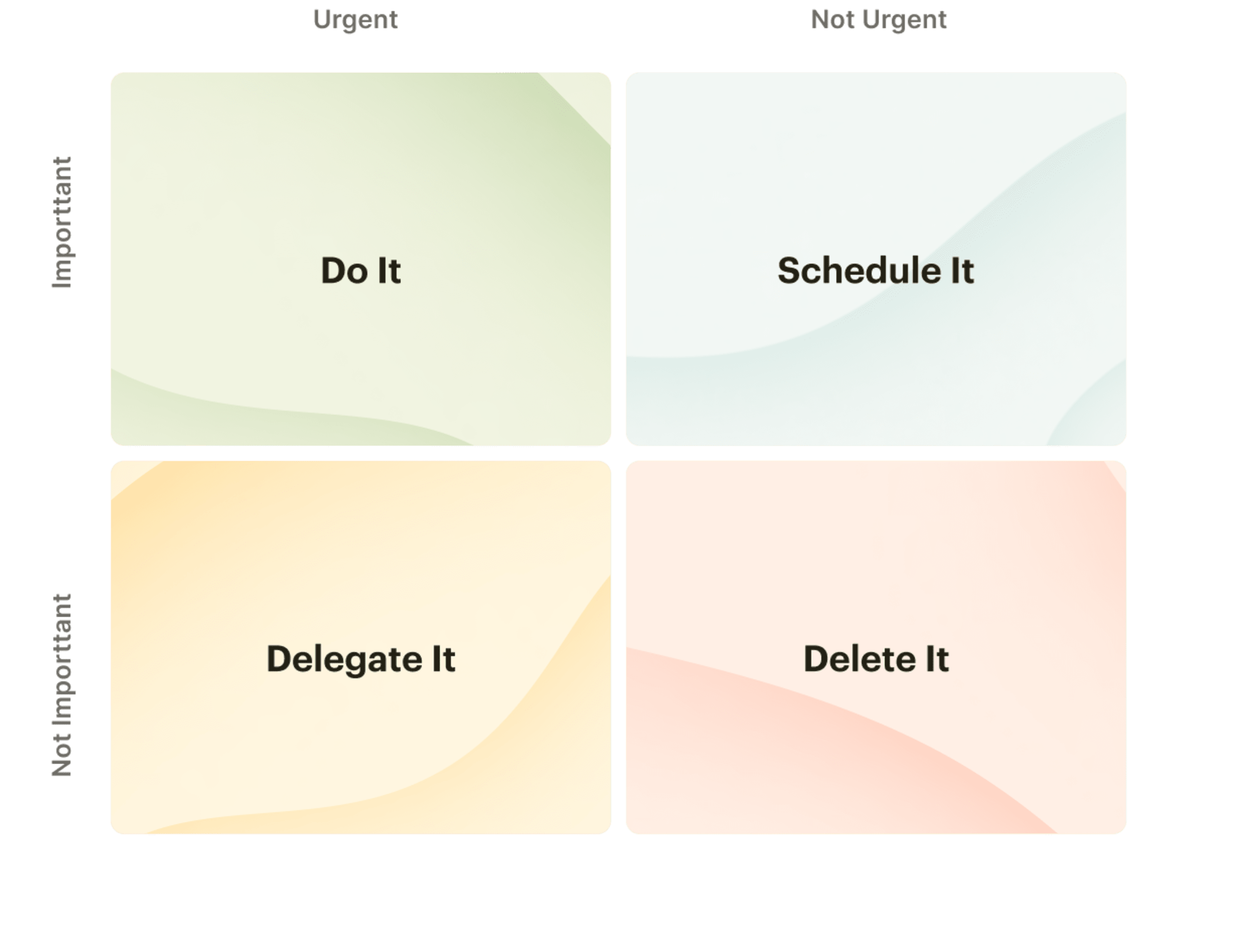
To start, craft your regular to-do list, including all your tasks for the day. Next, sort them into the four categories of “Urgent and Important”, “Non-Urgent and Important”, “Urgent and Unimportant”, and “Not Urgent and Unimportant”. Once you have these categories, act on your to-do list accordingly: do, schedule, delegate, and delete tasks from your to-do list as you plan out your day.
In time, this process will become second nature and you’ll naturally draft a single to-do list with only “Urgent and Important” and “Non-Urgent and Important” tasks on your list.
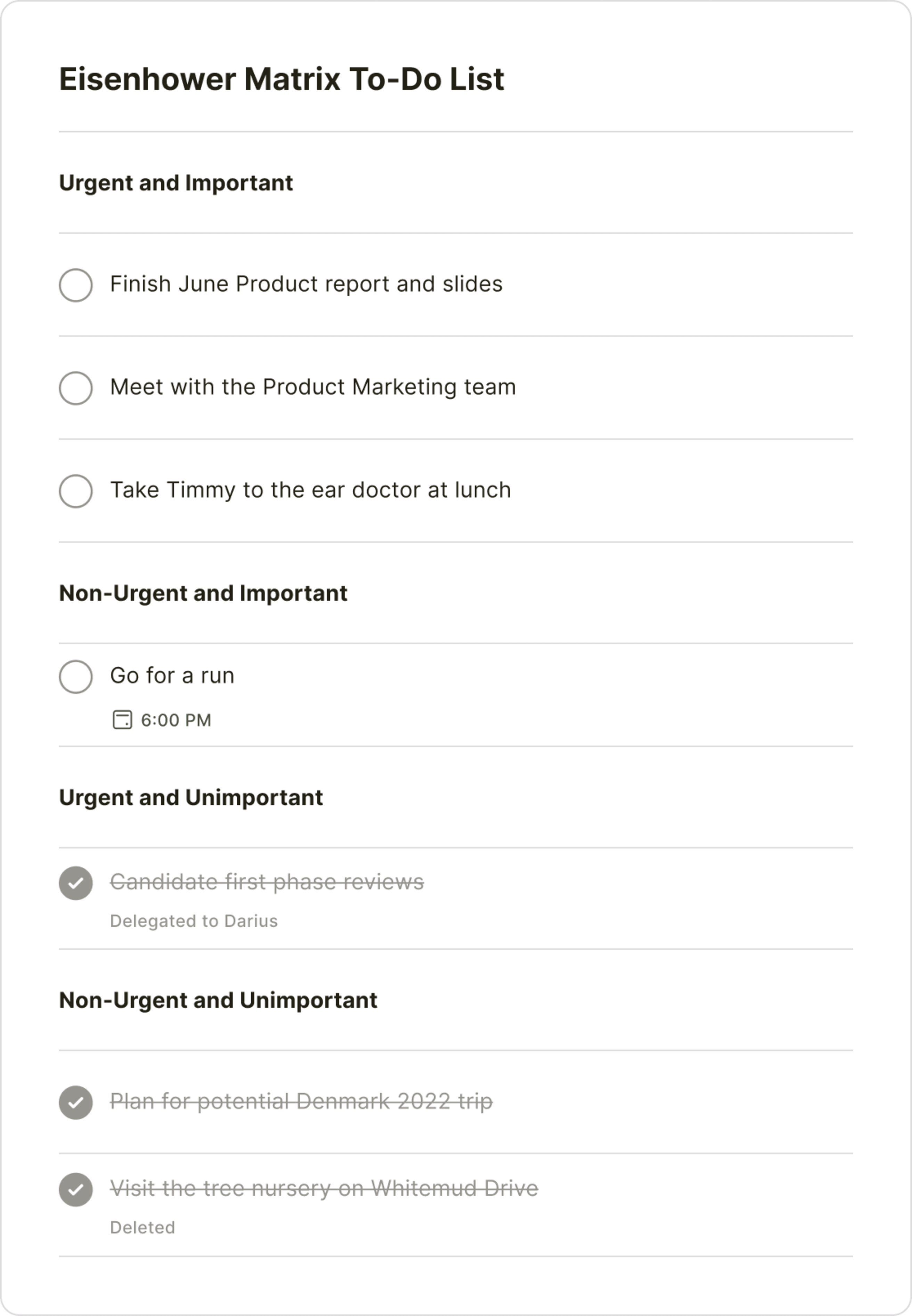
Choose your planning tool
You’ve decided on an approach to your daily planning—now it’s time to pick your tools. From productivity software to paper and pen, here are some of the most popular options:
A to-do list app
A digital task manager is a great choice for those who are tech-savvy and conditioned to reach for their phone or tablet instead of a notebook. To-do lists apps have the benefit of keeping everything in one place and accessible from anywhere. You can seamlessly move tasks from day to day as your plans change, organize relevant documents and links alongside your tasks, and have an automatic, searchable record of everything you’ve done.
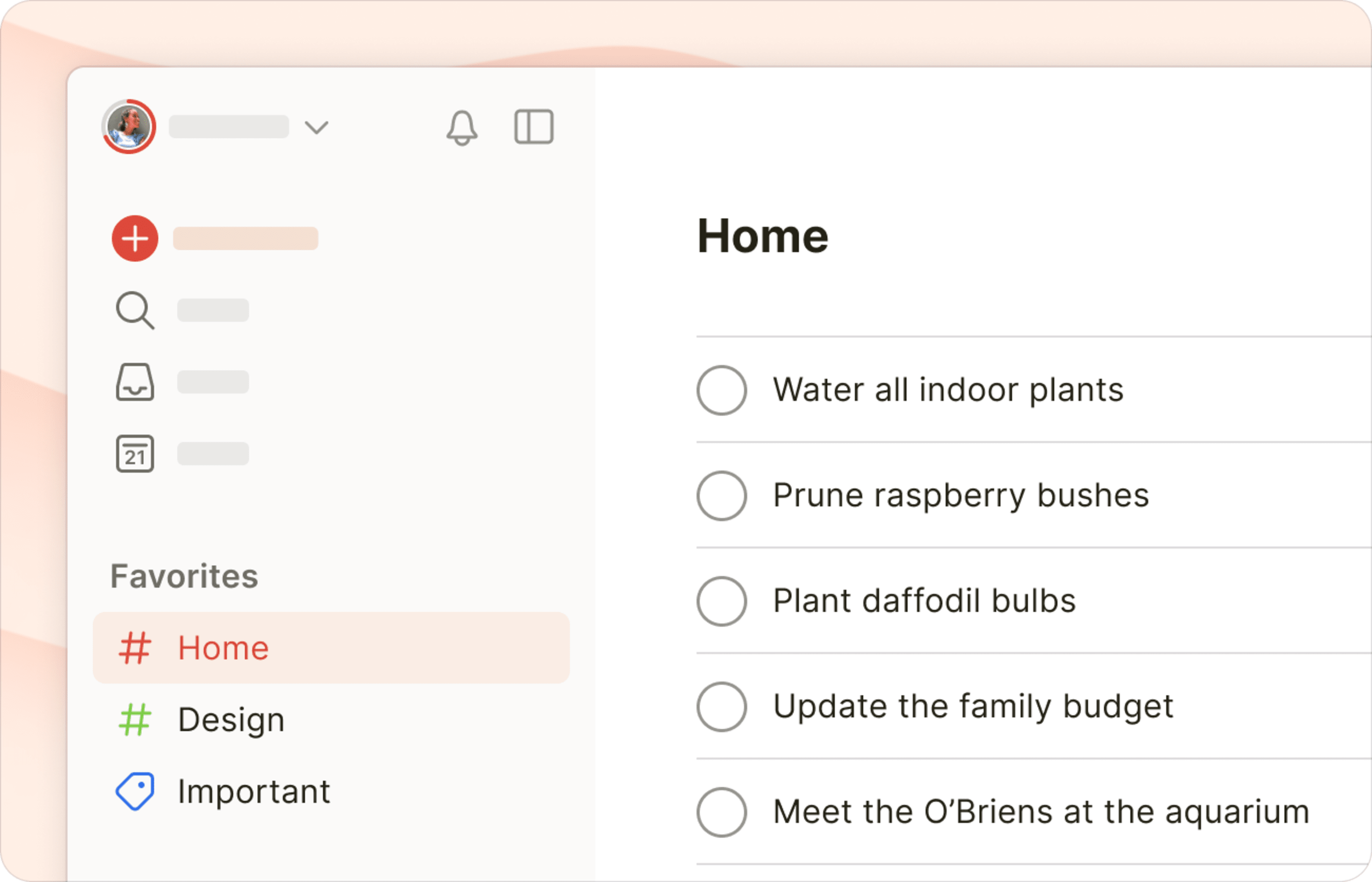
We recommend Todoist, our cross-platform personal to-do list app that’s available across most devices. The app includes many features like reminders, labels, filters, comments, and file uploads that make planning your day easier.
A digital list
If you’re not keen on a full-fledged task manager but still want a digital solution, consider less-specialized tools that you probably already use in your day-to-day at work and home.
- A notes app or word processing app. Use a simple notes app like Bear (iOS and MacOS only), Apple Notes, or Google Keep to keep a running list of your tasks for the day. Simply check off items using checkboxes or strikethrough formatting. For a more robust “notes” app, consider Google Docs or Microsoft Word for more flexibility and customization options.
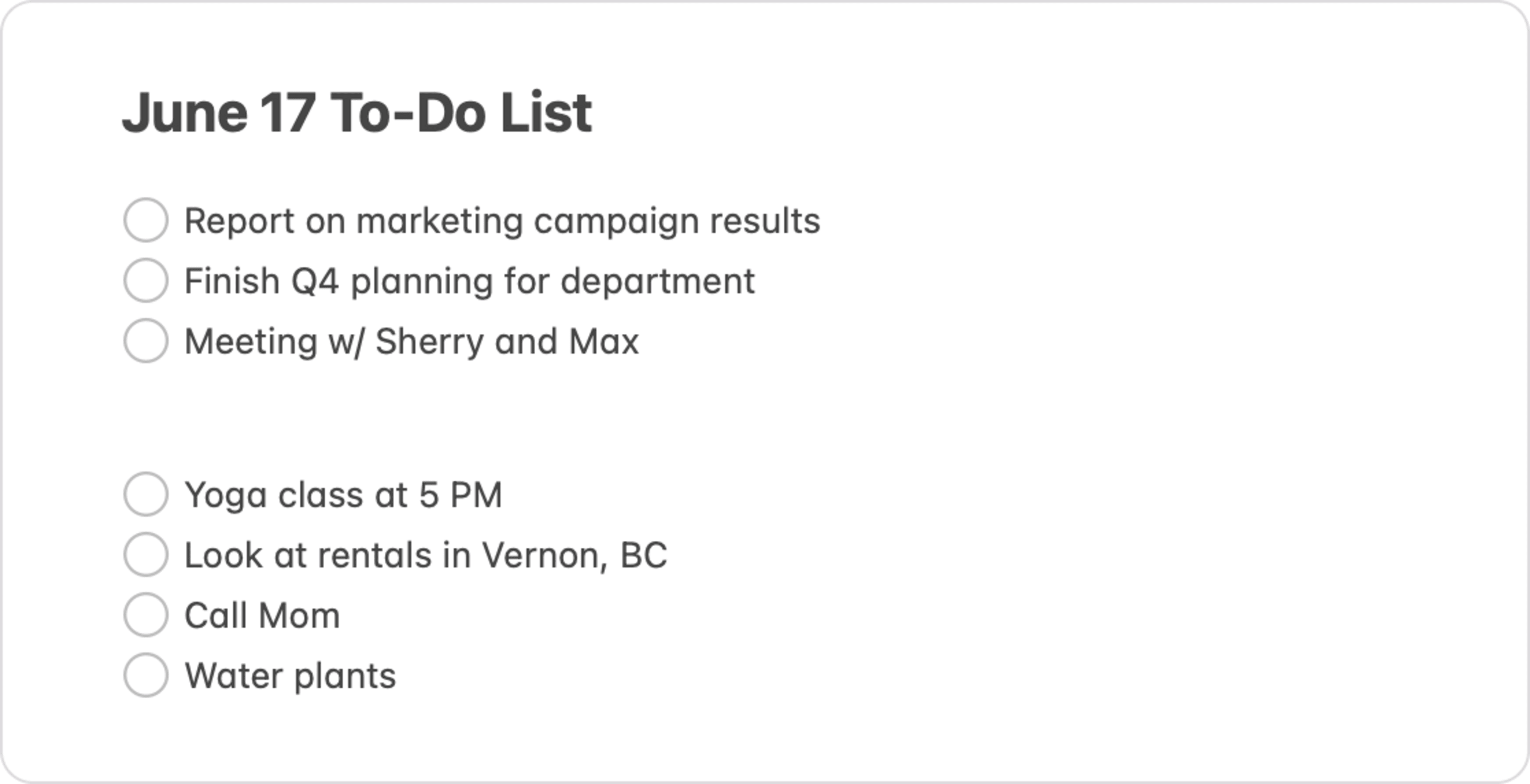
- Google Sheets or Excel. Plan your day in a spreadsheet. This can help you add more context and notes to specific cells. Methods like time-blocking are also conducive to working in a digital grid.
A digital calendar
Many people opt for a daily planning tool they’re already using –– the calendar. Apple Calendar, Google Calendar, Fantastical, and Woven are all popular calendar apps that you can use to plan your day and add your tasks alongside appointments, meetings, and events. This is also a great tool to use with a productivity method like time blocking. Additionally, digital calendars have the benefit of being available on the go, generally on both web and mobile.
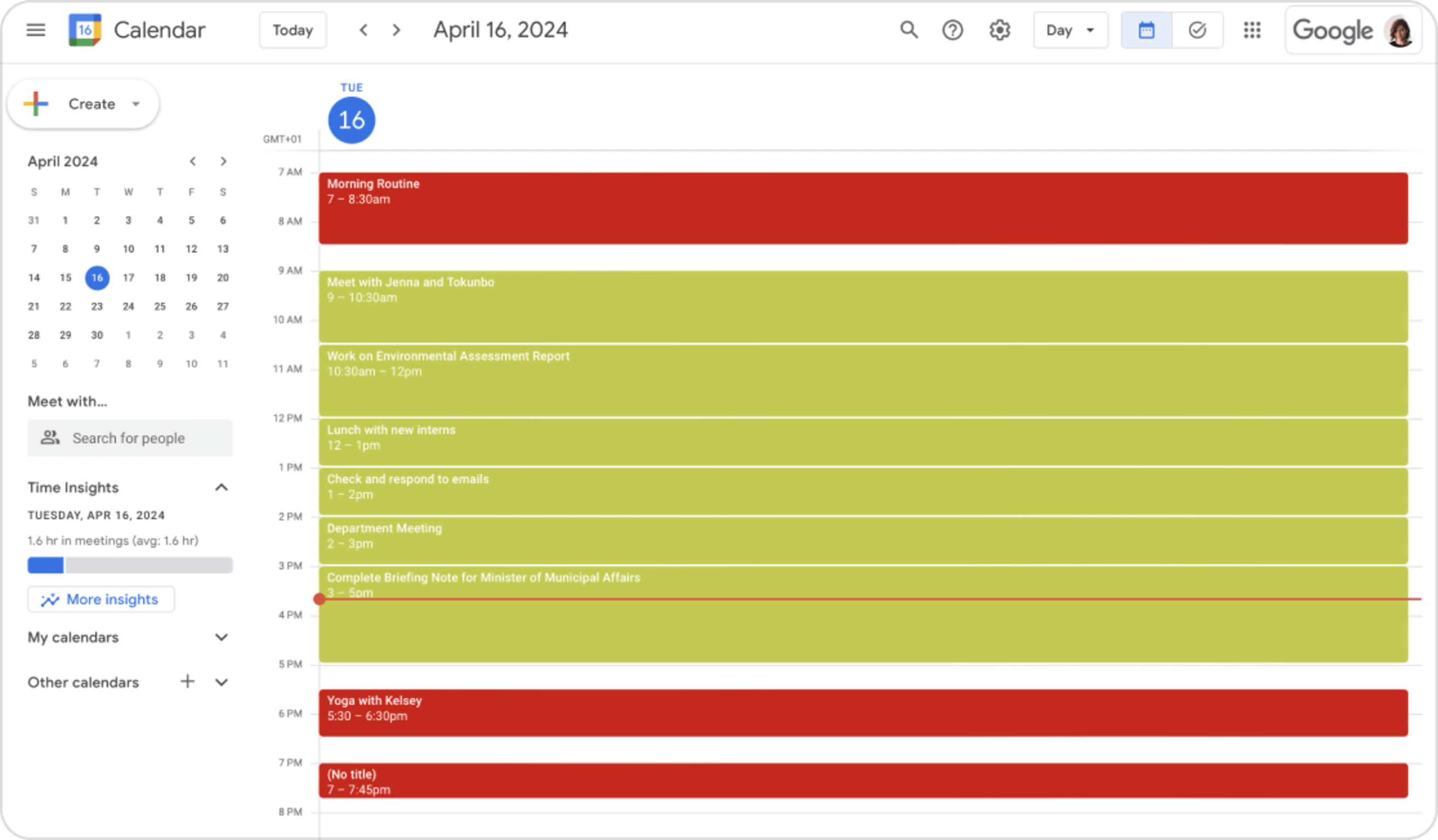
A paper planner
For the tactile among us, paper and pen is the go-to for planning your day. This can take any number of forms including notebooks, agendas, or specialized planners. We’d only caution against post-it notes or loose paper. While simple and scrappy, ad-hoc scraps of paper prevent you from looking back at old tasks and reflecting on the effectiveness of your daily planning. [See the “Reflect Regularly” section]
- Notebook — A simple lined or unlined notebook will do the trick for a simple pen and paper planning system. Use a new page for each day and mark the date at the top. Try gridded notebooks that can help with creating divisions if needed.
- Daily Agendas or Planners — Agendas or planers are notebooks with space to plan each day of the year from January 1 to December 31. This provides dedicated space for daily planning and the ability to go back to previous and upcoming entries with greater ease.
- Specialized Planners — We’re seeing the rise of specialized planers or paper and pen planning systems like the Passion Planner or Bullet Journal. These systems are often complex, but can be powerful systems for dedicated practitioners.
A paper planner can take any number of forms including notebooks, agendas, or specialized planners.
A digital and paper hybrid
When it comes to daily planning, you don’t need to choose pen and paper or digital tools –– you can use both or any combination of the methods mentioned. Here are a few different ways you can put a hybrid system to good use:
- Personal and professional split. Use a digital system for your professional tasks and a planner for your personal tasks. This can be a helpful method if you dedicate working hours to striving for professional goals and dedicate your evenings to personal tasks and self-growth. In the same vein, you might use a task manager during the week and a journal on the weekends.
- Paper first, digital second. You might enjoy the tactical aspect of planning your day on paper but appreciate the searchability and permanence of digital tools. Plan your day using a schedule or daily planner but make time at the end of each day to transfer your to-dos and progress to a digital task manager for easy reference. This is also a great method if you opt for paper notes to avoid distraction. For instance, you might bring a notebook into a meeting and leave with action items and requests you’ve scrawled in your notebook. You can then transfer these items to your digital to-do list, adding due dates and priority levels so they don’t fall through the cracks.
- Pen-and-paper thinking, digital execution. Some find that they’re more creative and think better when they have a blank page and a pen in hand. Get out your plans for the day on paper with any added notes and thoughts you might have. Then, move them to your digital to-do list to make your tasks more actionable.
How to stick with your daily plan & course-correct when needed
Even with a solid plan and the best of intentions, it’s difficult to complete all our to-dos for the day. We inevitably find ourselves off-task, lured by distractions like Twitter memes and online shopping. Ad-hoc tasks, assigned by our managers or delegated from teammates, can arise that break our focus and force us to concentrate on unplanned items.
Unfortunately, these interruptions can snowball into unproductive days and ineffective weeks. We decide that daily planning doesn’t work, and there’s no point in approaching our days with intention. That couldn’t be further from the truth!
Yes, our days will never go exactly as planned, but that doesn’t mean they aren’t worth planning. Here are a few strategies, some straight from productivity experts, for sticking with your daily plan and course correcting when things go awry.
Eliminate distractions
Stay focused by eliminating common distractions that pull you away from your objectives for the day –– especially if the bulk of your work is done with a computer. If possible, work with most of your desktop programs closed, with minimal tabs open, your phone on silent, and your notifications off.
If the call of social media scrolling is too strong, use a site blocker like Self Control or Freedom to make distracting websites inaccessible for hours at a time.
Track your time
Just like tracking your budget can naturally help you spend less, tracking your time can help you use it more effectively. Use an automatic tracking app like Rescue Time that collects information about usage on your desktop and mobile devices and sorts your time online into “productive”, “neutral”, and “distracting”. You can set daily productivity goals and check-in throughout the day to see whether or not you’re nearing your goal or falling short of the target.

Try hourly check-ins
Apply mindfulness to productivity by regularly checking in with yourself to notice if you’re moving through your day with focus.
Peter Bergman, an executive coach and the best-selling author of 18 Minutes, suggests setting a regular timer to refocus ourselves:
Readjust your plan
Sometimes unexpected tasks arise that we can’t ignore. That’s fine. The problem arises when we try to take on this unanticipated work without going back to revise our initial plans. Instead, make unplanned to-dos part of a new plan. When you have to shift to an off-book task, take a few minutes to readjust your plan for the day: reschedule to-dos to later in the day or move them to tomorrow. Then, work off of your new plan.
Cal Newport, a computer science professor at Georgetown University and the best-selling author of Deep Work, shares his approach to readjusting his daily plan using the time blocking method with pen and paper:
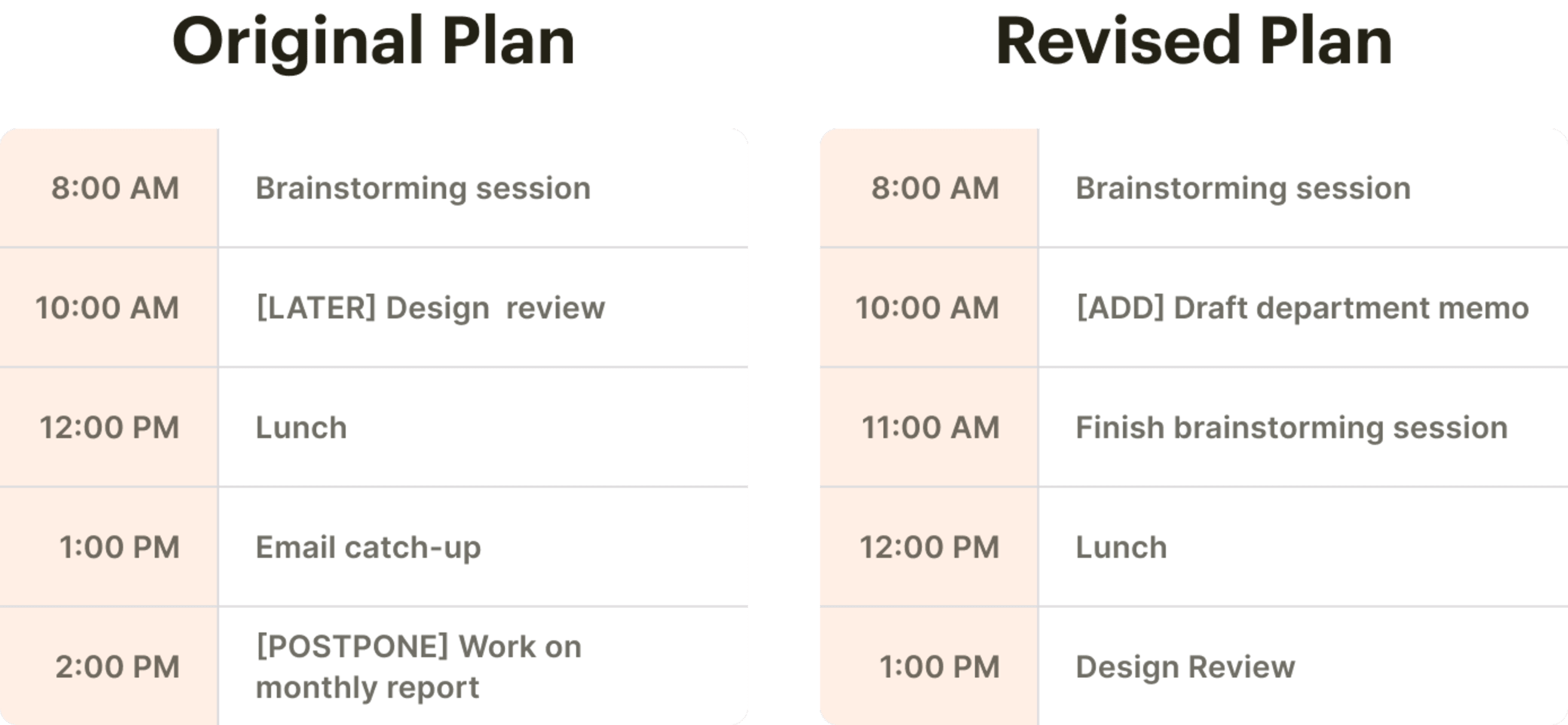
Get to “To Do List Zero”
Most days you won’t finish everything on your list. However, get to “To-do List Zero” anyways. Amir Salihefendić, the Founder and CEO of Doist, shares his personal productivity method, Systemist, including “To-do List Zero”, a concept inspired by Inbox Zero:
By ending the evening with a clean slate, we can avoid getting buried in overdue tasks and tackle tomorrow with renewed energy.
Reflect regularly
You’ve made planning your day a habit, translated your long-term goals into actionable tasks, chosen a productivity method, and selected your tool of choice. You’re set for more productive days that build to more meaningful weeks, months, and years.
However, don’t let your process run on autopilot. Take some time to regularly consider whether your approach to daily planning is helping you accomplish more. Make time every so often, perhaps during a weekly review, to consider whether your planning process is working or could be tweaked or even overhauled to be more effective.
Consider these questions:
- Are my days calm and intentional or stressful and haphazard?
- Did I complete all my daily planning sessions or skip some?
- Do I feel accomplished at the end of most days?
- Are my high priority days being addressed?
- Am I on track to meet my long-term goals?
- This day was especially productive — why?
- I accomplished nothing impactful on this day — why?
In being honest about how our days went and how we’re faring on our big goals, we can fine-tune our daily planning for better results. Hectic days might mean we need to prioritize more effectively or find a way to delegate work. Missing daily planning sessions might mean they’re too long and could benefit from a more streamlined approach. If we’re not moving towards our goals, it may mean we have too many or we’re not adding them to our days with enough frequency or intention. We might simply like pen and paper while we’ve forced ourselves to try a shiny new app. Whatever the issue, work to resolve it by modifying your daily planning process.
It’s not uncommon to need to experiment and try a few iterations of daily planning before we land on the method that actually lead to getting more done.
When planning your day, aim for consistency and flexibility over perfection. While we’ve provided tips and tactics for planning your day effectively, there’s no silver bullet solution. Instead, we feel the most ready to attack our day when we show up consistently. Productive days have a way of turning into productive weeks, months, and years. When we chip away at our tasks with intention and focus day by day, there’s no limit to what you can accomplish.

